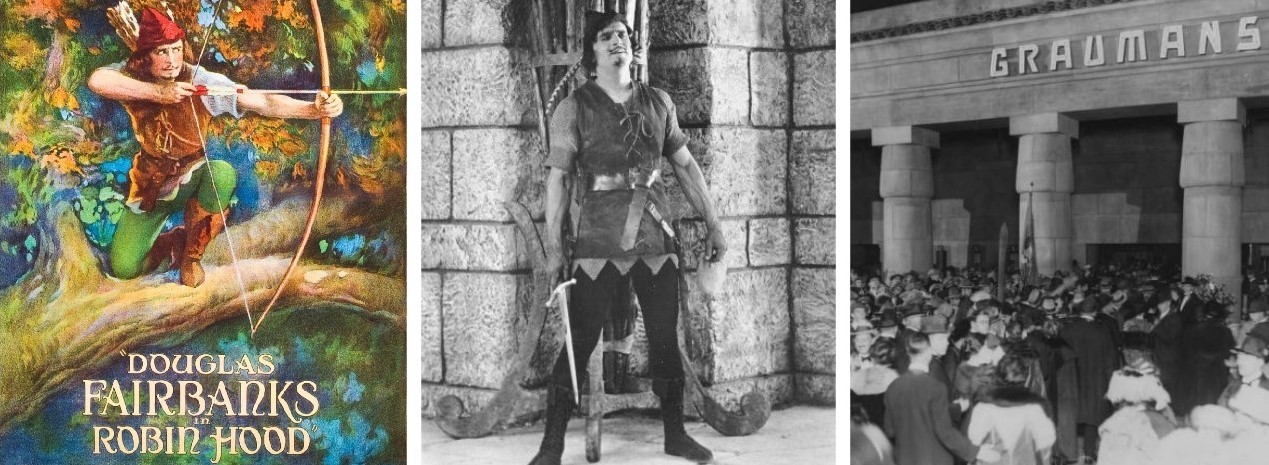Firsts in Film History
Do you ever wonder when a certain event happened for the first time in history? For someone as painfully curious as me, I do. And often. So, I thought it would be fun to find some firsts in film history. Here are 10 that I thought would be interesting to share.
1. The first ever motion picture to be made in Hollywood was In Old California (1910). Directed by D. W. Griffith for Biograph Company, the film was a 17-minute melodrama set in the early 19th century, when California was under Spanish and Mexican rule. It starred Frank Powell, Arthur V. Johnson, Marion Leonard and Henry B. Walthall. The short was considered lost for many decades, until a copy was found in 2004 and screened at the Beverly Hills Film Festival.
 |
| (from left to right) Marion Leonard, Henry B. Walthall and Arthur Johnson in In Old
California; D. W. Griffith in his office at Biograph Company in New York. |
2. The first ever movie to have a Hollywood premiere was Robin Hood (1922). Directed by Allan Dwan for United Artists, the film starred Douglas Fairbanks as the iconic title character, Enid Bennett as his love interest, Lady Marian, and Paul Dickey as the antagonist, Sir Guy of Gisbourne. One of the most expensive pictures of the 1920s, Robin Hood premiered at Grauman's Egyptian Theatre on October 18, 1922 and it was a massive critical and commercial success.
 |
| (from left to right) Original release poster for Robin Hood; Douglas Fairbanks as Robin Hood; Crowd outside of Grauman's Egyptian Theatre for the premiere. |
3. The first motion picture to have a full-length synchronised soundtrack was Don Juan (1926). The film used the Vitaphone sound-on-disc system, which was developed at Western Electric's Bell Laboratories in New York City and acquired by Warner Bros. in 1925. It has a synchronised musical score and sound effects, although it has no spoken dialogue.
 |
| (from left to right) Estelle Taylor and John Barrymore in Don Juan; the premiere of Don Juan at the Warners' Theatre in New York City, on August 5, 1926. |
 |
| (from left to right) Original poster for Lights of New York; Cullen Landis and Helene Costello in Lights of New York. |
6. The first ever motion picture made in Technicolor was The Gulf Between (1917). Starring Grace Darmond and Niles Welch, the film used Technicolor's «System 1,» a two-colour (red and green) process. Because of the technical difficulties in keeping the red and green images aligned during projection, it was the only motion picture made using this process.
 |
| (from left to right) Grace Darmond photographed for The Gulf Between; one of the few surviving frames of the film, which is considered lost. |
8. The first 3D film to be shown in front of an audience was The Power of Love (1922). It was directed by Nat G. Deverich and Harry K. Fairall, and starred Elliot Sparling, Barbara Bedford and Noah Beery. The film premiered at the Ambassador Hotel Theatre in Los Angeles on September 27, 1922, and used a red-and-green anaglyph system for the 3D experience.
 |
| (from left to right) A still from The Power of Love; Harry K. Fairall, who developed the method for making stereoscopic films; an early example of a 3D camera. |
9. The first ever full-length narrative feature film was The Story of the Kelly Gang (1906). With a running time of 60 minutes, this Australian picture was directed by Charles Tait and traced the exploits of 19th-century bushranger and outlaw Ned Kelly and his gang. It premiered at the Athenaeum Hall in Melbourne on December 26, 1906 and was a critical and commercial success. The film is now part of the UNESCO Memory of the World Register.
10. The first feature film to be shown on television was The Crooked Circle (1932). Directed by H. Bruce Humberstone, the detective flick starred ZaSu Pitts, James Gleason and Ben Lyon. It was broadcast for the first time on March 10, 1933 by the Don Lee Broadcasting System over their experimental station W6XAO, transmitting an 80-line resolution mechanical television picture to about 12 receiving sets in Los Angeles.
 |
| (from left to right) Poster for The Crooked Circle; ZaSu Pitts and James Gleason and The Crooked Circle. |
Do you know any other interesting firsts in film history that I can add to this list?






These are so cool! I wonder if any of the 12 who saw it on tv wrote anything down about it.
ReplyDelete